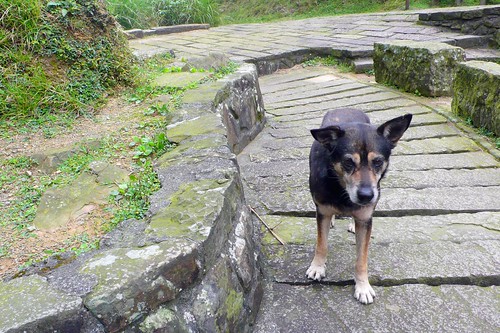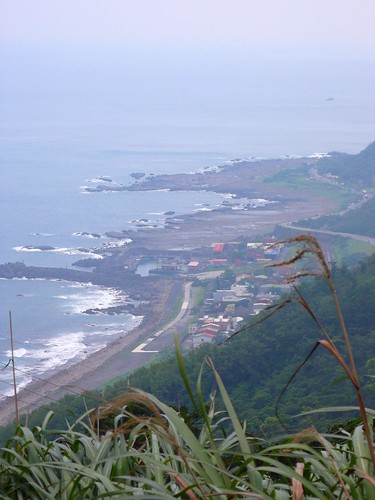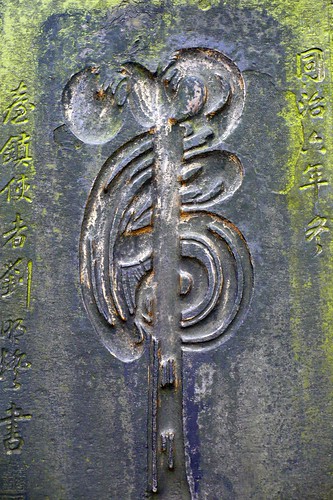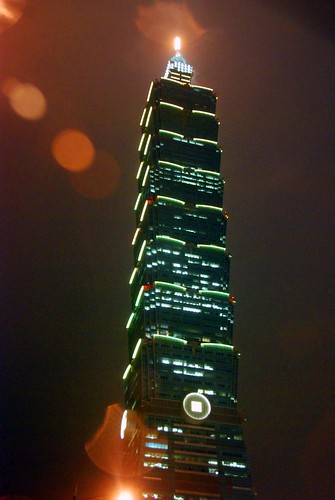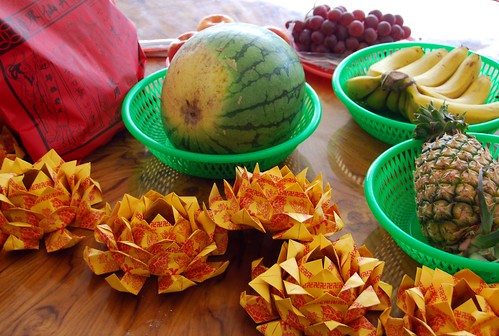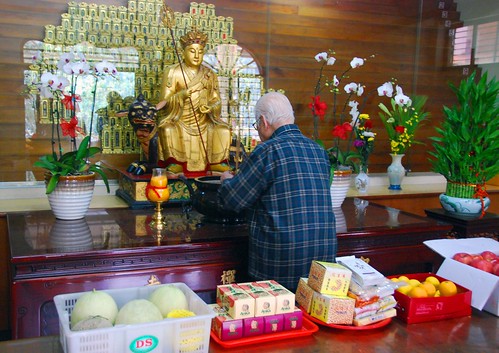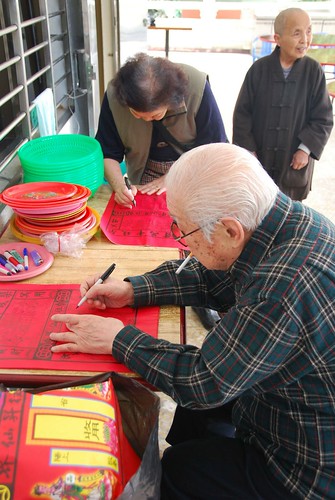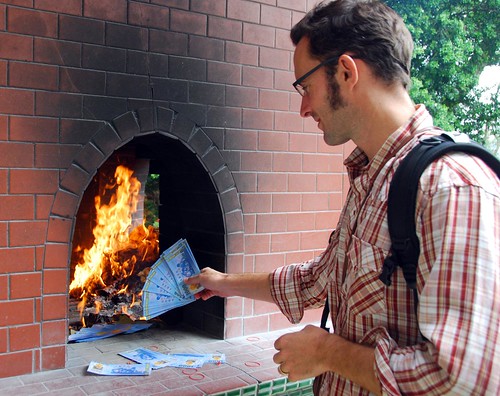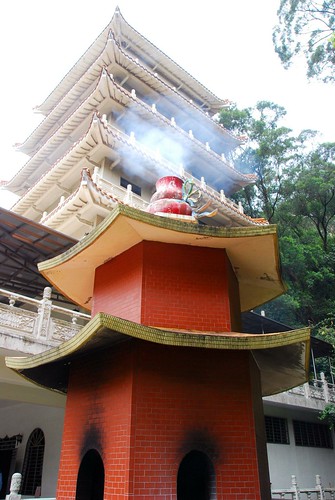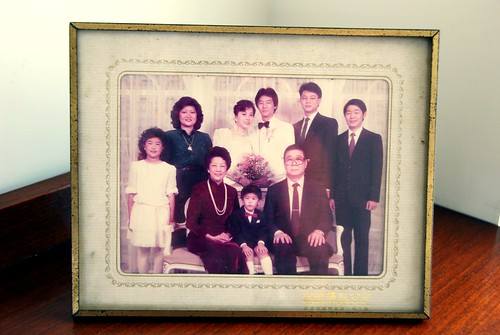Taiwan
Before arriving in Taiwan, I had no idea that the country was full of serious hikers. I guess I thought—like my own family—that the only hobby people from Taiwan really took seriously was eating. ![]() But it totally makes sense, this little island is blessed with a rugged coastline and a seriously mountainous interior (with several 3000m mountains!) and there are oodles of hiking trails to explore, many within day-trip distance of Taipei.
But it totally makes sense, this little island is blessed with a rugged coastline and a seriously mountainous interior (with several 3000m mountains!) and there are oodles of hiking trails to explore, many within day-trip distance of Taipei.
A few weekends back, Jeremy and I took a day trip out to the east coast of Taipei in order to hike the Cao Ling Historical Trail (căo líng gŭ dào), a 10km road (interestingly, most of the hiking trails we have encountered are actually stone-paved roads, unlike the dirt trails we have in the States) originally built in the early 1800s to provide transport from the ocean to Taipei. We started the hike in Dali and hiked to Fulong, though you could easily do it the other way around.
The train ride out there is quite beautiful…you pass through the longest tunnel in all of Asia before traveling along the rugged coastline towards Dali. This is the first time we have seen the ocean in Taiwan…weird to think that just on the other side of that blue expanse sits California (yup, Taiwan is bordered on the east side by the Pacific).
The trailhead begins right next to beautiful and elaborate Tiengong Temple (where, apparently, you can stay the night).
Early on in our hike, we acquired a four-legged friend, who stayed by our side pretty much the entire time, despite our best attempts to convince him that we weren’t going to give him any food. We even told him in two different languages!
The views of the coast were stunning as we climbed higher and higher into the mountains.
Cao Ling Historical Trail is most famous for two stone tablets that sit along the road. Both tablets were carved by an unfortunate traveler who got caught on the trail during one of Taiwan’s famous typhoons. Along the way, he carved the Chinese character for “tiger” (虎) into a rock (in Chinese mythology, the tiger is thought to control the winds), and the Tiger Tablet is now the trail’s most famous landmark.
A little while later, there is another enormous carved boulder reading, “Boldly quell the violent mists.” Poor guy, we had great weather while we were hiking, but even then it was still quite windy. I can only imagine what it must be like with a typhoon slamming into the side of the mountain!
Once you reach Fulong, you can head to the beach…there is a paid-entry area (I think it was NT$40 each, or about US$1.10), or you can walk a little further into town and access the beach for free (though the paid area is cleaner). Since we weren’t planning on hanging out at the beach for long, we just walked along the free area, but I can imagine that on a nice weekend this beach would be quite nice.
There is another really elaborate temple (I think it is Taoist? Apparently if the altar contains some fierce-looking bearded guys, then it is Taoist) on the far end of the beach in Fulong.
Taiwanese people may be serious about hiking, but there is another thing they take even more seriously (no it’s not food): hot springs! The country is full of them, and after Taiwan, I am not sure if I can face another hike if there is not a hot springs waiting for me at the end of it! From Fulong, we hopped on the train to Jiaoshi (about half an hour train ride south) to check out their public hot springs.
Jiaoshi’s public hot springs are segregated into men and women-only sections since no clothing is allowed. Entry is NT$80 each (about US$2.50), and women must wear shower caps (kind of bummer since it gets pretty hot in there).

This is actually Beitou Hot Springs (in northern Taipei), not Jiaoshi, but I thought you might like to see what a Taiwanese hot spring looks like. You can’t take photos inside Jiaoshi hot springs since everyone is, you know, naked.
A few things you should know before visiting Taiwan’s hot springs: first of all, they really put the “hot” in “hot springs.” If you dare to enter the hottest pool, be warned that the water will be scalding! You can tell by the myriad of lobster-colored Chinese men sitting around the springs.
Secondly, Taiwanese people have these funny exercises that they do in the hot springs (I think they are trying to promote blood circulation). You’ll often see these old Chinese guys doing pelvic thrusts or gyrating madly around the pools while slapping their own asses or beating themselves on the chest. It’s pretty amusing, to say the least.
Jiaoshi is also known for it’s cōng yóu bĭng (spring onion pancake). The most famous place is next door to the Jiaoshi post office; there will be a huge line out the door. Their version is deep-fried until the dough is puffy and glutinous, and you brush on your choice of three different sauces (soy, chili, and something else that tasted good) before they topped off with an egg. I don’t have a photo of this because I ate it too fast. YUM!!!
Cao Ling Historical Trail was a great outing and we recommend it if you’re ever out this way. It’s super close to Taipei (about an hour on the train) and a beautiful way to spend a nice day in Taiwan.
Taipei is an awesome place to live. Really. I mean, the food is great (don’t think there’s not a post on that topic coming!), there is almost no crime to speak of (in fact, the only arrest we’ve heard of is a man who caused a riot by emptying a sack full of money in the middle of Taipei—yes, you read the correctly…the only crime we’ve heard of is someone giving out money), and the people here are incredibly polite and helpful, almost forcefully so. I always love discovering the peculiarities of a place, and Taipei has no shortage of distinctive qualities…read on if this is the type of thing you’re interested in too. ![]()
These Have to be the World’s Longest Addresses
No joke, this could seriously be someone’s street address:
#3, Alley 15, Lane 80, Zhong Shan North Road, Section 2, 4th Floor, #5
OK, let me help you decipher: this person lives on Zhong Shan North Road, Section 2. All major streets in Taipei are aligned to a grid, with a central axis point more or less around Taipei Main Station (an absolutely enormous labyrinth-like confluence of buses, subway, high-speed rail, and regular railway…with 4 underground shopping malls thrown in for good measure). All major roads are broken into north/south or east/west depending on where they are located in relation to the axis (i.e., Zhong Shan North Road is the length of road to the north of Main Station). Major streets are further broken into sections, and the closer you are to the axis (i.e., Taipei Main Station), the smaller the section number (i.e., section 2 is closer to main station than section 5).
To find this address, you need to be in section 2 of Zhong Shan North Road. Taipei also has numbered lanes that run perpendicular to major streets. To find Lane 80, walk up to where the building numbered 80 should be…that’s where you’ll find the lane. Similarly, alleys are perpendicular to lanes and you will find alley 15 where the building numbered 15 should be (luckily, there is nothing smaller than an alley).
Here, let’s give your brain a break…look at a pretty picture:
Taipei cityscape, taken right outside of Taipei Main Station’s entrance M8.
OK, we’re almost there…we are at Alley 15, Lane 80, Zhong Shan North Road, Section 2. Now you need to find building #3 in this complex, head to the 4th floor, and find apartment #5. Schwoo! That wasn’t so hard, was it?
Once you get the hang of it, this address system works really well—actually, Jeremy thinks it is brilliant. In effect, every address is like a built-in map. You really only need to know the major roads in order to find an address…and quite honestly, in a city as densely populated as Taipei, this is a really logical way of organizing things.
Yeah, OK, Not So Fast…Wades and Giles were Smoking Crack
Alright, the address system is very logical and organized, but there are a few complexities. All streets in Taipei are labeled in both Chinese and English, but the difficulties arise in the Romanization of the Chinese language. Namely, Taipei used to use the Wade-Giles Romanization system (which I find quite unintuitive), but recently switched over to the Hanyu Pinyin system, in line with mainland China (BTW, I am only familiar with the Hanyu Pinyin system, so any Mandarin words that are mentioned on 12FOOT3 will use this system).
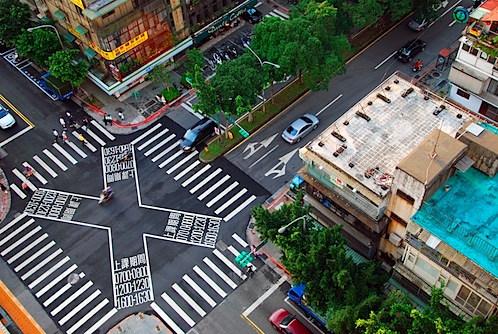
The view of the street below from our 14th floor balcony.
Taipei has done a good job of switching all street signs over to the Hanyu Pinyin system, but most business addresses still use the Wade-Giles system. So, you might get an address that reads, “Chung Hsiao East Road,” but try Googling this and you’ll get nowhere, because the Hanyu Pinyin version is actually “Zhong Xiao East Road.”
In fact, if Taipei were to be named according to the Hanyu Pinyin system, it would actually be Taibei. Note that while the street names have been translated over to Hanyu Pinyin, all city names are still spelled according to the Wade-Giles system.
Public Transport: Get Your 上 and 下 on!
The Taipei subway system (MRT) is cheap, super fast, clean, and easy to use (all signage is in English and Chinese, so even non-Mandarin speakers can find their way around). The bus, however, is a different story. Although the subway is awesome, it doesn’t reach every little nook and cranny of Taipei, but the bus system does. The problem is, there is no bus guidebook in English, so you’re just going to have to ask for help getting where you want to go (see the next section for more on getting help).
The buses have this weird system where you pay when you get on or get off (and depending on how far you’re traveling on the bus, sometimes both). There is a sign above the driver’s head that has the Chinese character for “up” (上) or “down” (下). If “up” is lit, you pay when boarding the bus; if “down” is lit, then you pay when you get off. If “up” is lit when you get on and “down” is lit when you want to get off, then you pay both times.
People will Fight Each Other to Help You
If you happen to get lost in Taipei, don’t worry, because someone will help you. Seriously, don’t ask anyone for help unless you really mean it, because Taiwanese people are aggressively helpful. On more than one occasion, we’ve asked someone for directions, only to have the person next to them start arguing that their directions are not direct enough. Pretty soon, the entire bus is arguing about what is the fastest, most efficient way for the two foreigners to get to point B (in at least three different languages).
Which way to Taipei 101?
We’re not exaggerating—we’ve been out on the middle of nowhere, lost on a hiking trail…finally, someone comes along and we ask directions. Without fail, another person will magically appear out of the ether and start arguing that the path person 1 has recommended will take too long and that he knows a quicker way.
Welcome, Oh Glorious Benefactor!
The Lonely Planet suggests that Taiwanese are helpful towards foreigners because they are just happy that you know they exist, given the fact that they are often overshadowed by the bigger, more controversial neighbor to the north. But I disagree—I think it is because Chinese kids are raised to be extremely well-mannered and polite (ke qi), and respectful towards others, especially towards the elderly. I understand this firsthand because these are some of the values that my own parents stressed to my brother and I when we were growing up. Of course, Eddo and I grew up in the States so we’ve sort of got the worst of both worlds…Chinese enough to know better but American enough to rebel against it (ahem, just kidding, Mom and Dad!). ![]()
The first example you’ll see of this famous politeness is on the bus. Whenever an old person gets on, people will immediately get up and offer that person their seat. Same goes for someone with a small child, or a pregnant woman. There is no hesitation; and often several people will stand up at the same time in a rush to offer the old person their chair.
Perhaps the most amazing display of good manners is on escalators. EVERYBODY stands in a neat, single-file line to the right side of the escalator, with those who wish to walk passing on the left. Jeremy was amazed by this! Don’t believe me? See for yourself! Not a person out of place.
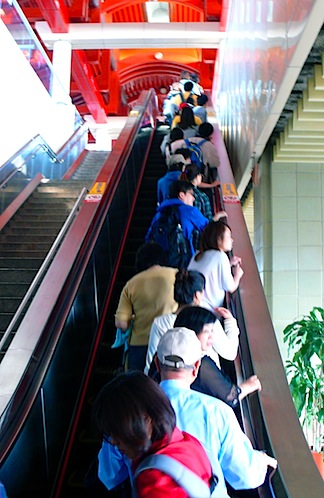
This politeness means that people never, ever say “can I get by?” if you are in their way. Instead, it’s “dui bu qi” (”I’m sorry”). Also, if you ask them a question that they can’t answer, a simple “I’m sorry, I don’t know” won’t suffice: it’s “bu hao yi si” (”I’m embarrassed”). In fact, the other day, Jeremy was sitting in someone’s train seat and the guy came up and said, “bu hao yi si,” instead of “hey, buddy, you’re in my seat.” Of course, when he saw that the reason why Jeremy was sitting in his seat was due to an old person sitting in Jeremy’s, he wouldn’t claim his seat, even though it meant he would have to stand the 3.5 hour ride back to Taipei.
This politeness does get a bit extreme in the stores. When you walk into a 7-Eleven (they are everywhere here), you are immediately greeted with “Huan ying guang ling!!!” Which, roughly translated, means something like “Welcome to you, Oh glorious descendant from the heavens!!!” When you leave, they will say “Xie xie hui gu!!!” Which equates to “Thank you for your benevolent patronage.”
****************
All of these little curiosities make Taipei a breath of fresh air after the madness in SE Asia. It is one of the most civilized places we’ve ever been, which is awesome considering we will be here for a good portion of our trip. Of course, it will also make it difficult to leave. ![]()
About a week after we arrived, my grandfather came back to Taiwan from a multi-week trip to China (and he has since gone back to the States, where he now lives most of the year). A couple of years ago, he had an operation that damaged some of his vocal chords, and he couldn’t really speak for a long time, but he has since recovered from that and it was fun to “get to know him” again. For a large majority of the time that Jeremy has known my Gong Gong (that’s Mandarin for “maternal grandfather”—Chinese people have different words for “grandma,” “grandpa,” “aunt,” “uncle,” etc. based on what side of the family they are on and whether they are older or younger than your parents), he has been more or less mute, so J was delighted to discover his personality: about 50% grumpy old man, 50% elder statesman, with a wicked sense of humor mixed in.
While Gong Gong was here, it just so happened to be Tomb Sweeping Day (Qing Ming Jie), a national holiday where you honor to your ancestors by praying before their grave sites, offering food, and burning paper money. It’s called “Tomb Sweeping Day” because traditionally, you clean up around the grave site and make sure your ancestor’s final resting place is clean and comfortable for them.
On Tomb Sweeping Day, we went to pay our respects to Gong Gong’s mother and his older brother at a nearby…I don’t know what you call it…mausoleum? It is a large building where a loved one’s remains are kept indoors in small cubbies. We brought lots of food:
And we paid respects to our ancestors by lighting incense and praying to them (bai bai) at a small altar:
Meanwhile, my grandpa, his niece (my Da Ah-yi), and her son were writing wishes for their loved ones on large red envelopes and filling them with paper money.
Then, we burned the paper money in a large outdoor furnace. FYI, paper money is burned so that your ancestors can “spend” it in heaven. It is often embellished with gold or silver foil stamps. It is important to fold the papers before placing them in the furnace (though I’m not sure why). I found out later that the paper money with a silver foil is for the newly-deceased, and gold-foil stamped papers are burned for gods or for your loved ones that have been gone for a while (and have therefore taken on god-like status). However, they also have paper money that looks just like the US and New Taiwan dollar. It is, after all, all about the Benjamins.
The furnace routed the smoke from the burning paper money directly towards the mausoleum (where my great-grandmother’s ashes are kept), which I thought was quite poetic.
I am really grateful that we had the opportunity to take part in Tomb Sweeping Day. Though I don’t remember my great-grandmother, my mom told me that she held me when I was little, and since I didn’t know how I was supposed to pray to her at the altar, I just closed my eyes and thought of myself as a little baby being held in her arms before bai‘ing. It was really meaningful to me to make this connection with my ancestors, and to take part in rituals that are part of my family’s culture and history.
We’re in Taipei! Actually, we’ve been here for about 3 weeks…I’ve been lagging on finishing up the SE Asia posts. Taipei is the city where my parents grew up; like many Chinese nationals, my grandparents moved to Taiwan around 1949 because of the Communist Revolution in China. If you are an ABC (American-born Chinese), like I am, this is probably part of your family history too.
I’ve been to Taipei a couple of times, but I was really young and don’t remember much about either experience, except that it was really crowded and the food was good. Apparently much has changed (the buses are no longer human sardine cans due to the introduction of a super-modern high-speed subway), but much has not (the food is still really, really good). The last time I was here, I was a mere 10 years old (and incidentally, I left Taipei with a perm and 10 extra pounds—just about the only time in my life I could be considered “pudgy”). Don’t believe me? Behold, the awesomeness of the visual evidence (click on the photo for a larger view):
Yes, that is me on the left. But look at Eddo!!! So adorable! (Sorry, Eddo).
My maternal grandparents still own an apartment here, though they live in San Diego most of the year now. Jeremy and I will be here for almost two months taking Chinese lessons. I can speak but have forgotten how to read/write; Jeremy took about 6 months of lessons 2 years ago and will continue on trying to master basic Mandarin, which is about as difficult as me trying to learn orthopedic surgery. But, as is Jeremy’s usual style, he has taken on the challenge like a champ and our language skills are improving day by day.
Though I haven’t set foot on this island for over 20 years, on the plane ride over here, I was still struck by the unmistakeable feeling that I was going home…and in a way, this is the closest to home we will get on the trip. Two months in the same place feels like an absolute luxury after all the traveling we did in SE Asia. And what a place to grow some (albeit shallow) roots! My grandparents’ apartment is rad…3 bedrooms, 2 bathrooms, and best of all, a kitchen (!!!) AND laundry!

Our apartment complex; we live in the back of the building on the left.
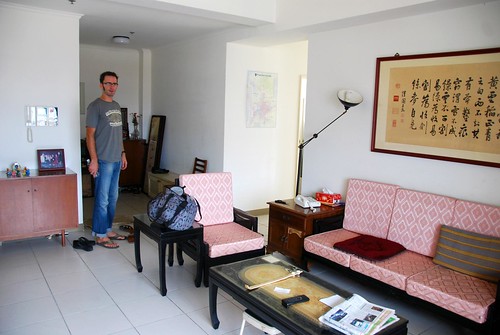
Jeremy in my grandparents’ living room.
And just to make sure we’re absolutely pimping, we’re located on the 14th (top) floor…
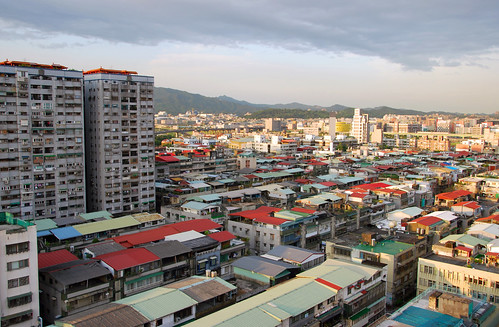
The view from the balcony of our 14th floor apartment in Taipei.
…in an absolutely prime location (Taipei 101 is just down the street). We are stoked!

Taipei 101, currently the world’s tallest building.
A bit of clarification on my Chinese language skills: Mandarin was my first language, but I pretty much only speak with my family. More accurately, we speak Chinglish, which my brother defines as “40% Chinese, 40% English, and 20% grunting.” As a result, even though my grammar is pretty good, my vocabulary is quite limited. For instance, before I got to Taipei, I did not know the words for “subway” or “passport.” Since my accent is halfway decent, people in Taipei assume that I can understand everything they are saying, but when they ask me a question, I can understand everything except for the noun that the entire sentence is built around. For example, I had this jewel of a conversation when I went to get my hair cut:
Hair stylist: Would you like some sfadsogn?
Me: Uh, what’s sfadsogn?
Hs: Oh, hmm…sfadsogn is like fudbhimm.
Me: I don’t understand.
Hs: You know, normally do the rwerfffl after the dfnskjn.
Me: I still don’t understand.
Hs: It will make your hair soft.
Me: OH!!! Conditioner! Yes, I want it.
Typically, this lack of vocabulary is not a problem when I am speaking…for instance, I don’t know how to ask for the “tourist information center,” but I can ask for “the place where foreigners who are traveling go to ask questions.” The problem only arises when other people are speaking to me. ![]()
This made our first couple days in Taiwan pretty interesting, as we went straight to work taking care of things like: getting a SIM card for our cell phone, acquiring internet access at the apartment, getting a haircut, and finding a school. You know, normal stuff you do in your everyday life. But just imagine that everyone is speaking to you in Pig Latin. You can figure it out, it just takes a little while to decipher.
Since we’re planning on a much less aggressive travel schedule while we’re here in Taiwan, we’ll use this opportunity to do a bit of maintenance on the site and (hopefully) finally get to some oft-requested posts about stuff like gear and trip prep. Thanks for all your hilarious comments and sweet messages. Having you all traveling along with us makes it easier to be away from home for so long. ![]()


